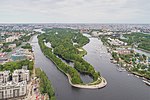Staraya Derevnya (Saint Petersburg Metro)
Railway stations in Russia opened in 1999Railway stations located underground in RussiaRussian railway station stubsRussian rapid transit stubsSaint Petersburg Metro stations

Staraya Derevnya (Russian: Старая Деревня) (literally translate - Old Village) is a station on the Frunzensko-Primorskaya Line of Saint Petersburg Metro, opened on January 14, 1999.
Excerpt from the Wikipedia article Staraya Derevnya (Saint Petersburg Metro) (License: CC BY-SA 3.0, Authors, Images).Staraya Derevnya (Saint Petersburg Metro)
Торфяная дорога, Saint Petersburg
Geographical coordinates (GPS) Address Nearby Places Show on map
Geographical coordinates (GPS)
| Latitude | Longitude |
|---|---|
| N 59.989611 ° | E 30.255111 ° |
Address
Торфяная дорога 4
197372 Saint Petersburg (округ Озеро Долгое)
Saint Petersburg, Russia
Open on Google Maps









